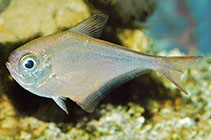| Family: |
Pempheridae (Sweepers) |
| Max. size: |
14 cm SL (male/unsexed) |
| Environment: |
reef-associated; marine; depth range 1 - 15 m |
| Distribution: |
Western Indian Ocean: South Africa and Mozambique. |
| Diagnosis: |
Dorsal spines (total): 6-6; Dorsal soft rays (total): 9-10; Anal spines: 3-3; Anal soft rays: 38-44; Vertebrae: 25-25. This species is distinguished by the following characters: D VI,9-10 (usually 9); A III,38-44; pectoral rays 17-19; lateral-line scales 53-60; chest entirely with ctenoid scales; caudal fin scaled on about basal fourth; gill rakers 28-33; body depth 2.2-2.35 in SL; head length 3.3-3.4 in SL; orbit diameter 7.15-7.7 in SL; longest dorsal ray 3.7-4.05 in SL; pectoral-fin length 3.3-3.55 in SL; colour in alcohol gray-brown, scale edges narrowly gray, the dorsal fin brownish gray with an apical black spot, the color of anal fin like body basally, with a broad blackish middle zone, the margin narrowly whitish, the caudal fin is yellowish gray, paired fins are pale yellowish, the pectorals with a dark brown band across base, the iris is grayish blue (Ref. 97766). |
| Biology: |
Occurs in exposed rocky shores and often in small groups that shelter in caves or beneath ledges by day from depths as little as 1-2 m to at least 15 m. It has been observed to venture out of shelter at night to feed on planktonic invertebrates and larval fishes. It was also reported to have an extensive spawning season, judging from seeing shoals of juveniles through
most of the year. The gonads of adults were noted to be nearly always mature regardless of the time of year. It was also observed to swim slowly, when not stressed, propelling itself mainly by characteristic ‘sweeps’ of the pectoral fins (hence the common name sweeper). Smallest fully mature female specimen, 11.6 cm SL (Ref. 97766). |
| IUCN Red List Status: |
Not Evaluated (N.E.) Ref. (130435)
|
| Threat to humans: |
harmless |
Source and more info: www.fishbase.org. For personal, classroom, and other internal use only. Not for publication.
